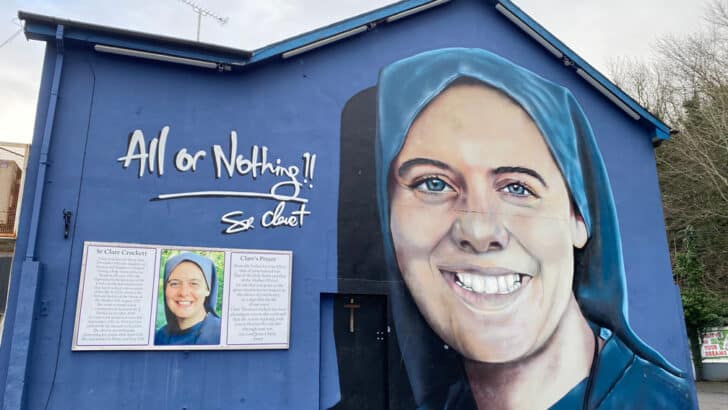The story of a nun’s diary, found in the dust of a derelict house, captured my attention the other day. It came from a rather unexpected source: the author and republican, Danny Morrison, who I first met as a political correspondent in Belfast, long before I ever considered entering a convent myself!
Mr Morrison had heard, on the news, that Sr Clare Crockett had just been made a Servant of God. And, reminded of another religious woman, also from Co. Derry, he emailed me a chapter from his book All the Dead Voices.
Although mainly about his uncle, Harry White, an IRA man born in Belfast in 1916, the chapter concludes with the discovery of the nun’s diary. And so, in the power of the Holy Spirit, the lives of these two Derry girls, one famous, and one hidden, became entwined in a surprising tapestry.
The diary belonged to Sr Mary Columba, and while she was pondering her path to sainthood, on retreat in Belfast in 1939, Harry White was deeply engaged in his own mission, travelling to Liverpool to bomb England. Sr Mary Columba and the IRA man had very different struggles. White trained IRA recruits at Killiney Castle in Dublin, among them Brendan Behan, author of the Borstal Boy, and Sr Columba Mary engaged in spiritual battle, through the “cold, hard dry work of praying before the Tabernacle.”
Perseverance
Her perseverance paid off, as she later records: “Most people get a wrong idea of prayer in the beginning…A heart to heart talk with a very dear friend should be, and is, the true idea of prayer.”
Her writing reveals a great desire to help others: “… I will especially pray for the souls of priests and the forgotten ones who have none to pray for them. Oh! how many are waiting for our help…”
When Harry White sought refuge at his Aunt Susan’s door in Glasgow, she said two things: ‘You have blood on your hands!’ and ‘I am going to Lourdes, but I held back because I knew you were coming’”
Harry White’s connection to the nun is revealed when Morrison finds himself in Altaghoney, a townland near Claudy, in Co. Derry, and pays a visit to a house, now derelict, where his uncle had spent some time ‘on the run’ in the 1940s. His ‘safe house’ in fact belonged to the nun’s family, the O’Kanes. While Sr Mary Columba was long gone when the IRA man arrived, (she had entered the Sisters of Nazareth in the 1920s and spent most of her life in England), her younger sisters, Brigid and Rose, remained and were sympathetic to White’s cause.
Like many of their generation, they held their religion and their politics in a curious tension. Indeed, when Harry White sought refuge at his Aunt Susan’s door in Glasgow, she said two things: “You have blood on your hands!” and “I am going to Lourdes, but I held back because I knew you were coming”.
By the 1990s, the O’Kane home was a place where old ghosts meet, quite abandoned, with broken windows, torn curtains and fading wallpaper. “In the ruins,” wrote Mr Morrison. “I found her prayer book, Treasure of the Sanctuary, containing hundreds of tracts.”
Among the old photographs, books, cards for Christmas and St Patrick’s Day, Mr Morrison spied a note, written by Sr Mary Columba, recording a cherished visit from her “dear father” to her convent in Hammersmith in July 1924.
Treading
Morrison had the family’s permission for his search but still felt he was treading on old relics. He discovered the nun’s diary with the words: “Today I shall go blind for our darling Lord’s sake. I will look on no face but His and see nothing but Him.”
The journal was written in pencil with gaps of several years, even decades, between the entries: 1933; 1938; 1939; 1942; 1943; 1944; 1953; 1972. The final entries were scribbled in shaky handwriting and reveal an openness to the changes of Vatican II.
Our darling Lord doesn’t want my head, he wants my heart – my love… my heart just as it is”
Morrison, who handed the precious items to the family, thought that parts of the diary were similar to St Thérèse of Lisieux’s biography, The Story of a Soul. He was struck by Sr Mary Columba’s reflections on love and eternal life: “Little things on little wings lead little souls to Heaven.”
In another passage, she writes: “Our darling Lord doesn’t want my head, he wants my heart – my love… my heart just as it is.”
“…On waking each morning I will bid my darling Lord, ‘Good Morning’, and clasp His hand, telling Him we shall spend the day together. That He is all mine, and I am all His. And when night comes, I shall always say, ‘Good Night’ before going to sleep and again tell Him how I love Him.”
This religious woman certainly does not fit the media stereotype of the harsh-faced nun in habit. “It is better to go out from Our Lord’s Table,” she writes, “with a smile for everyone.”
Sr Columba Mary also declares: “We are not made to keep Rules only but to be generous in our outlook in kindness to others, helping them in their difficulties …”
“Our Lord was not severe in His dealings – remember Magdalene, the good thief…”
She reflects on the limits of science which is powerless to bring “eternity within our grasp.” “My eternity is in my own hands. I can make it a happy one – or I can make it miserable…”
Eternity
Sr Columba Mary passed into eternity on August 1, 1975, at St Joseph’s home in Derry. Regrettably, an historical inquiry institutions run by the Church and State between 1922 and 1995 found abuses at homes run by her order. “It is clear that at certain times, and with certain nuns, things were just not right,” said Sr Brenda McCall, who apologised on behalf of the Sisters of Nazareth. She also rightly praised the work of some “wonderful and inspirational nuns”.
I began to wonder where Sr Columba Mary was buried, and with a friend went to Derry last Friday. Records show she is not interred in her home parish in Claudy – nor with the Sisters of Nazareth in Derry City Cemetery.
I did however find the grave of Sr Clare Crockett, and after giving thanks, left a posy with a pink tulip, and marvelled at the ripples, magical connections, that now flow through her grace-filled life. The mystery was solved when Fr Gerard Mongan later confirmed that she is buried at St Columba’s in Longtower.


 Martina Purdy
Martina Purdy